
Among the tapestry of global cultural celebrations, Rosh Hashanah stands out as a blend of solemn reflection and joyful anticipation, marking the Jewish New Year. This holiday not only commemorates the creation of the world but also serves as a time for personal introspection, renewal, and the commencement of a ten-day period of judgment leading up to Yom Kippur, the Day of Atonement. Delving into the origins, significance, and timing of Rosh Hashanah, this article seeks to elucidate the multifaceted nature of the celebration and address the fascinating contrast between it and the biblical New Year month of Nissan, revealing layers of tradition that have contributed to the richness of Jewish heritage.
Rosh Hashanah as the Jewish New Year
Rosh Hashanah, which translates to “head of the year” in Hebrew, is celebrated on the first two days of Tishrei, the seventh month of the Hebrew calendar, typically falling in September or October. This observance marks the start of the Jewish civil year, contrasting with the religious calendar where Nisan holds the position of the first month. The commencement of Rosh Hashanah is heralded by the blowing of the shofar, a ram’s horn, which serves as a call to repentance and a reminder of the bond between God and the people of Israel.
Exploring the Significance of Rosh Hashanah in Jewish Tradition
In Jewish tradition, Rosh Hashanah signifies more than just the beginning of a new year; it embodies a period of introspection, judgment, and the embracing of new possibilities. It is believed that on this day, God opens the Book of Life and the Book of Death, deciding who will live or die in the coming year. This period, known as the Days of Awe, culminates in Yom Kippur, when the judgment is sealed. The customs observed during Rosh Hashanah, including the sounding of the shofar, casting off sins in a body of water (Tashlich), and eating symbolic foods, intertwine to create a potent experience of renewal and moral realignment.
Confusion Around Rosh Hashanah: Timing and True Meaning
The timing and theological underpinning of Rosh Hashanah can sometimes lead to confusion, especially given the distinct mention of Nisan as the “first month” in the Bible, specifically in the context of the Exodus story. The designation of Tishrei as the beginning of the civil new year reflects post-exilic influences and the adaptation of Jewish tradition to the realities of the agricultural calendar. This duality underscores the complexity of Jewish timekeeping and the rich tapestry of historical and cultural factors that shape the observance of holidays.
Nissan: The Biblical New Year Month and Its Importance
In contrast to Tishrei, Nissan holds a pivotal position in the biblical and historical narrative of the Jewish people. Marked as the first month in the religious calendar, Nissan commemorates the Exodus from Egypt, symbolizing liberation and the birth of the Jewish nation. The distinction between Nissan as the “biblical new year” and Tishrei as the “civil new year” underscores the multifaceted nature of Jewish tradition, where different aspects of life—spiritual, agricultural, and communal—are celebrated and sanctified throughout the year.
The observance of Rosh Hashanah and the acknowledgment of Nissan as the traditional New Year month weave together threads of memory, anticipation, and communal identity. By exploring these practices and their significance, we gain insight into the continuity and evolution of Jewish tradition, reflecting the enduring bond between a people and their faith across the ages.





